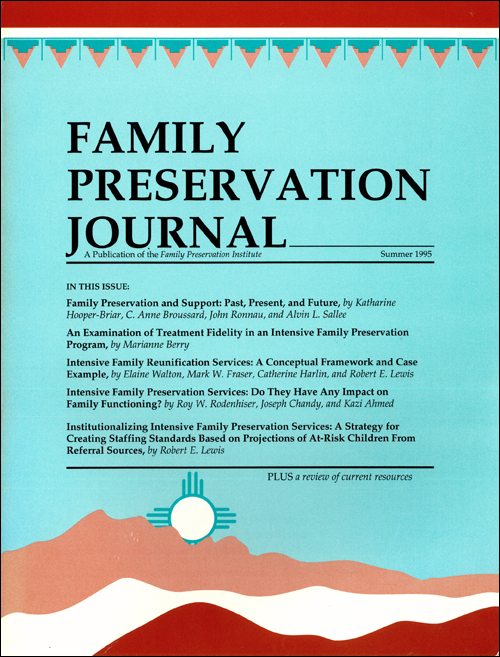This is the first of two posts on the role of academia over the 40 years that IFPS has been in existence. From the beginning, IFPS has been one of the most researched and written about models of human services. Frequently this work was undertaken by faculty at colleges and universities across the nation.
In 1995 the Family Preservation Institute within the Department of Social Work, New Mexico State University, released the first issue of the Family Preservation Journal. Printing costs were covered by subscriptions. Professors John Ronnau and Alvin Sallee stated the purpose of the Journal: “to provide a forum in which practitioners, administrators, researchers, and educators in family preservation may present and critically review their findings, issues, and concerns. In the process, the family preservation culture and approach will be refined and invigorated.” Over twenty additional college and university professors served on the Editorial Board.
Articles in the first issue included:
- A proposal that universities adopt a family preservation and support agenda as one of their missions in surrounding communities and regions.
- A conceptual framework for reunification. A case example was analyzed using a conceptual framework that included social learning theory, client-centered approach, and ecological systems theory.
- In a research study article, four assessment scales were used to determine change in family functioning based on the IFPS intervention. The results indicated that IFPS had a positive effect on family functioning.
- The Journal also included a review of books and training materials. A professor commented on a 43-minute video of HOMEBUILDERS® IFPS training in which eight vignettes were presented to demonstrate behavioral-cognitive skills.
The following is an excerpt from the findings that reflected changes in parenting for families receiving IFPS:
Table 4
Child Well-Being Scales
|
Child Well-Being Scale |
Pretest Mean |
Posttest Mean |
T-Value |
| Child well-being scale (44 items) |
88.8 |
90.9 |
***-3.37 |
| Parental disposition (14 items) |
82.3 |
86.8 |
***-4.32 |
| Children’s adequacy of mental health care |
88.9 |
93.9 |
-1.95 |
| Parental capacity of child care |
88.6 |
88.8 |
-.10 |
| Parental recognition of problems in the family |
68.9 |
78.8 |
**-3.26 |
| Parental motivation to solve problems |
76.4 |
80.9 |
*-2.20 |
| Parental cooperation with case planning |
86.9 |
87.0 |
-.04 |
| Parental acceptance of children |
80.6 |
82.9 |
**-3.10 |
| Parental approval of children |
82.9 |
87.3 |
**-2.97 |
| Parental expectations of children |
81.1 |
97.6 |
***-3.39 |
| Parental consistency of discipline |
80.5 |
87.4 |
***-3.50 |
| Teaching/stimulating children |
85.7 |
87.0 |
-1.09 |
| Protection from abuse |
85.0 |
92.5 |
-1.79 |
| Abusive physical discipline |
87.9 |
6.51 |
*-2.40 |
| Threat of abuse |
89.8 |
94.7 |
**-2.73 |
p
* = <.05
** = <.01
*** = <.00
This brief overview of the first issue of the Family Preservation Journal indicates the role of the Journal in aiding to establish the foundation, theory, research, best practice, tools, and resources that would undergird the development and expansion of IFPS. A publication founded and supported by academia and devoted solely to family preservation lent legitimacy and credibility to the movement.
The publication’s name was later changed to the Journal of Family Strengths. Issues of the Family Preservation Journal are now available free online. Here is the link to the first issue: (PDF, 10.6 MB)
http://bit.ly/1bPGMkq
_______________
Posted by Priscilla Martens, Executive Director, National Family Preservation Network

